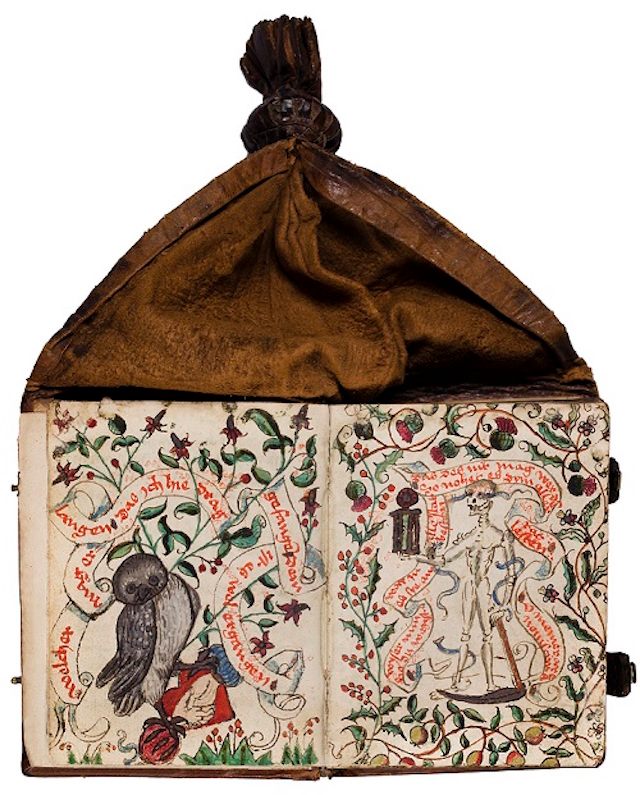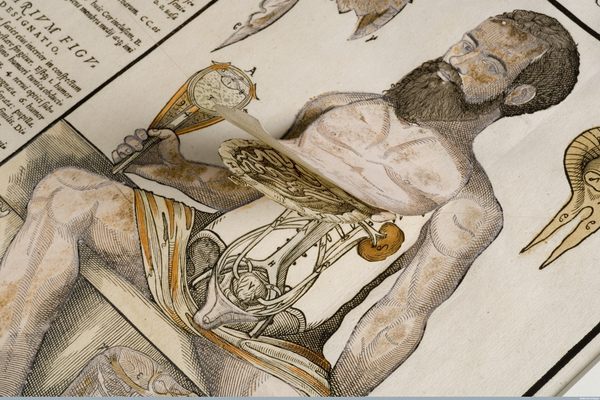Go Medieval by Attaching a Book to Your Belt
They’re incredibly rare today, but portable girdle books were once very handy.

Girdle books had to be small, and they had to be light. From the bottom edges of their bindings extended an length of leather, usually gathered into a knot at the end. This extension of the cover could be used to carry the book like a purse or could be tucked into a girdle or belt. To read, the owner wouldn’t even have to detach the book; when taken up, the book would be oriented correctly, just as if it had been pulled from a shelf.
Used from the 14th to 17th centuries, these books were texts that their owners needed to keep close at hand: prayer books used by monks and nuns, for example, or law books used by traveling judges. Though they were valuable objects—luxuries, even—these books were meant to be consulted and read.
“These are books that needed to be specially protected because of a lot of use, a lot of wear. Most of them were probably used daily,” says Margit J. Smith, author of The Medieval Girdle Book. “How many books do you have in your collection that you use every day?”
Girdle books were once common enough that they appear more than 800 times in paintings and other art of the period. But today there are just 26 girdle books known in the world. In her book, a catalogue of what she calls “relics of an age long gone by,” Smith has measured, photographed, and investigated the history of each one.

Smith, a bookbinder and retired librarian who was the head of cataloguing and preservation at the University of San Diego’s Copley Library, first became interested in girdle books 15 years ago, and she took a class in Montefiascone, Italy, to learn how to make one. In her preparations, she found that there was little scholarly work—little information at all, really—on these once relatively common objects.
The class took place in summer, and usually, after their work was over, the group would go for a dip in the nearby lake. On one of these excursions, Smith was asking an instructor, Jim Bloxam, where to find more research about the books; together, they decided to start collecting images of all known medieval girdle books—just 24 at that time. After some years of work, Bloxam, a conservator at Cambridge University, had to drop out of the project, but Smith, who says she’s interested in “odd things”—she likes to read words backwards and has written about the silverfish that threaten book bindings—continued visiting the world’s few remaining girdle books.

When libraries placed these objects, hundreds of years old, in front of her, she felt a sense of awe. “Then you start looking into it, and you see all the debris from 500 years ago. There is dust and hair and fingernail parings and spots of wax from candles and erasures,” she says. “Some of the books are so fragile that you have to be very careful, especially when turning pages. But if you start measuring, once you get into that, you remember what you are there to do, and you’ve overcome the initial awe.” The books, while still treasures, became objects to be scrutinized.
The part of the book cover that distinguishes a girdle book often looks like a Wee Willie Winkie hat, flopped on top of the book, or a Gandalf-esque beard, stretching down into a neat triangle. Smith discovered that some girdle books have just one extended leather cover, while other have two nested covers, with the outer one designed for carrying. But it wasn’t always easy to tell which category a girdle book fit into. One of the first things Smith learned as a bookbinder was how to tear a book down, to see how it worked. In modern books, it’s possible to tease back an endpaper and inspect a book’s secrets. In the case of the old, rare books, that wasn’t possible, so Smith had to run her fingers along the binding to feel for ridges and other hints to the book’s inner workings.
“You close your eyes,” she says. “As a bookbinder, I have learned to trust my fingers more than my eyes.”

In the course of her research, Smith discovered the existence of two additional girdle books. One is in Scotland, the psalter of Neal McBeath, the smallest of all the known girdle books. Just 2.5 inches by 1 7/8 inch, the book fit easily into the palm of her hand. It didn’t have a spine, just the leather wrapping, and it showed little sign of repair. In Vienna, she found another new girdle book, but this one refused to give up its secrets. Years of repair work on it had concealed most clues about its construction. The girdle cover, for instance, may have been a later addition. “There are unusual bumps and protrusions under there,” she says. “It’s sort of mystery. I’d like to be able to take it apart completely and see what went on before, before the binding was put on.”
Some of the books had surprises inside, as well. One belonged to a nun, Katharina Röder von Rodeck, who lived at the Frauenalb Convent near Karlsruhe, Germany. She filled the pages with her personal prayers and devotions, as well as notes about her life—when she took her vows, when German peasants rebelled in 1525. At the beginning of the book, she decorated five pages with the coats of arms of her parents’ families, a gray owl holding a red heart, a skeleton holding an hourglass, and motifs of flowers and vines that continued throughout the book. It gives, writes Smith, “a very cheerful and friendly impression.”




















Follow us on Twitter to get the latest on the world's hidden wonders.
Like us on Facebook to get the latest on the world's hidden wonders.
Follow us on Twitter Like us on Facebook